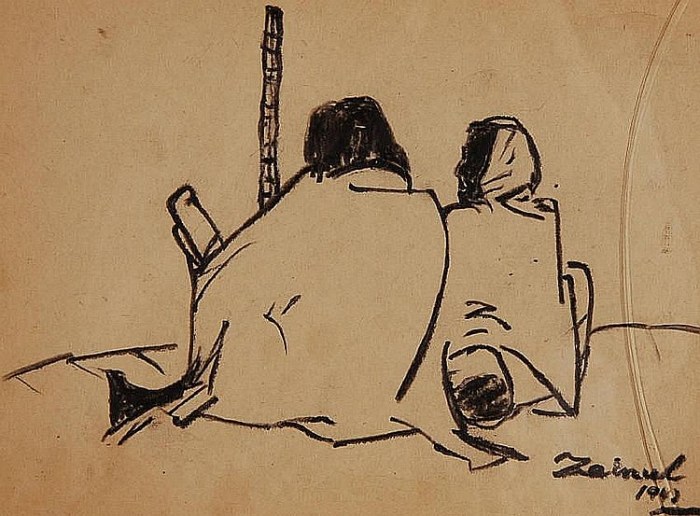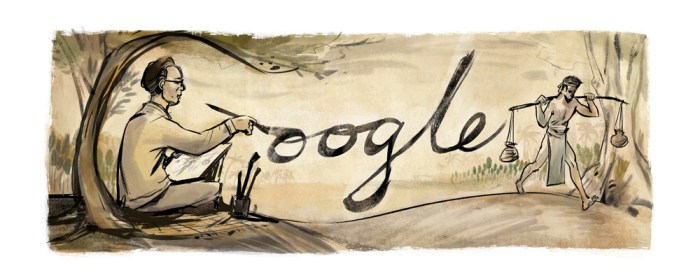Famine sketches of zainul abedin – Zainul Abedin’s famine sketches, a poignant and powerful series of artworks, immortalize the devastating Bengal famine of 1943. Through bold lines, muted colors, and simplified forms, Abedin captured the horrors of famine and human suffering, humanizing the victims and exposing the systemic failures that contributed to the tragedy.
Abedin’s artistic style and techniques conveyed the horrors of famine and human suffering with stark clarity. Influenced by traditional Bengali art and folk motifs, his sketches explored recurring themes of hunger, poverty, disease, and death, capturing the emotional and psychological toll of famine on individuals and communities.
Historical Context of Zainul Abedin’s Famine Sketches
The devastating Bengal famine of 1943, which claimed the lives of millions, profoundly impacted Zainul Abedin’s life and artistic career. The famine was a direct result of the British colonial government’s policies, which diverted food supplies to the war effort and neglected the needs of the local population.
Abedin, who had already established himself as a leading artist in British-occupied India, witnessed the horrors of the famine firsthand. He was deeply moved by the suffering he saw and felt compelled to use his art to document the tragedy and raise awareness of the plight of the victims.
Socio-Political Climate
The socio-political climate of British-occupied India during the 1940s was complex and volatile. The Indian independence movement was gaining momentum, and there was widespread resentment against British rule. The famine exacerbated these tensions and led to widespread protests and unrest.
Personal Experiences
Abedin’s personal experiences during the famine shaped his artistic response. He witnessed the death of his mother and many other family members and friends. These losses left an indelible mark on his psyche and fueled his determination to expose the human cost of the famine.
Artistic Style and Techniques: Famine Sketches Of Zainul Abedin
Zainul Abedin’s artistic style was characterized by its stark simplicity, bold lines, and muted colors. His sketches depicted the horrors of famine and human suffering with a raw and unflinching honesty.
Abedin’s use of simplified forms and muted colors emphasized the gauntness and despair of the famine victims. His bold lines conveyed a sense of urgency and desperation, capturing the physical and emotional toll of the famine.
Influence of Traditional Bengali Art
Abedin’s sketches also drew inspiration from traditional Bengali art and folk motifs. He incorporated elements such as the “alpona” (floor art) and “pata” (scroll painting) into his work, creating a unique blend of traditional and modern artistic styles.
- Alpona: Abedin’s use of geometric patterns and motifs, reminiscent of traditional alpona designs, added a sense of cultural identity and rootedness to his sketches.
- Pata: The influence of pata scroll paintings can be seen in Abedin’s use of sequential panels to narrate the story of the famine, capturing the unfolding tragedy in a visually compelling manner.
Thematic Content of the Sketches

Zainul Abedin’s famine sketches are a powerful and moving depiction of the human toll of the 1943 Bengal famine. Through his art, Abedin captured the suffering and despair of the victims, exposing the devastating effects of hunger, poverty, disease, and death.
Abedin’s sketches humanized the victims of the famine, portraying them not as statistics but as individuals with faces, stories, and emotions. His art captured the psychological toll of the famine, conveying the feelings of hopelessness, despair, and loss that gripped the people of Bengal.
Recurring Themes
The recurring themes explored in Abedin’s famine sketches include:
- Hunger and starvation
- Poverty and destitution
- Disease and illness
li>Death and mourning
Abedin’s sketches vividly depict the physical and emotional suffering endured by the victims of the famine. His art serves as a testament to the resilience and strength of the human spirit in the face of adversity.
Social and Political Commentary

Zainul Abedin’s famine sketches transcended mere artistic expression, serving as a potent form of social and political commentary. Through his evocative imagery, Abedin denounced the systemic failures and injustices that had led to the catastrophic famine.
Critique of British Colonial Rule
Abedin’s sketches unflinchingly exposed the exploitative policies of British colonial rule that had exacerbated the famine. Depictions of emaciated bodies, skeletal figures, and desolate landscapes laid bare the devastating consequences of colonial extraction, unequal land distribution, and the prioritization of cash crops over food production.
Exposure of Systemic Failures
Beyond critiquing British rule, Abedin’s sketches highlighted the systemic failures within Bengali society. He condemned the hoarding and profiteering by wealthy landlords and merchants, who profited from the desperation of the starving masses. Abedin also criticized the government’s inadequate relief efforts and the apathy of the elite towards the suffering of the poor.
Mobilizing Support for Relief Efforts, Famine sketches of zainul abedin
Abedin’s sketches played a pivotal role in raising awareness about the famine and mobilizing support for relief efforts. His artworks were widely reproduced and exhibited, generating international outrage and galvanizing public pressure on the British government to take action. Abedin’s sketches became a symbol of the human cost of colonialism and a call for humanitarian aid.
Legacy and Impact

Zainul Abedin’s famine sketches have left an enduring legacy in Bangladesh and beyond, serving as a powerful testament to the horrors of famine and the urgent need for social justice.
Abedin’s sketches have been widely used to educate future generations about the devastating effects of famine. They have been incorporated into textbooks, documentaries, and museum exhibitions, helping to raise awareness of the issue and inspire compassion and action.
Recognition and Awards
Abedin’s famine sketches have garnered widespread recognition and accolades. In 1974, he was awarded the Bangladesh Shilpakala Academy Award for his contribution to the arts. In 2012, the United Nations Postal Administration issued a stamp featuring one of his famine sketches, recognizing the global impact of his work.
Abedin’s sketches have also been exhibited in prestigious galleries and museums around the world, including the Victoria and Albert Museum in London and the Smithsonian Institution in Washington, D.C. These exhibitions have helped to solidify Abedin’s status as one of the most important artists of the 20th century.
Questions and Answers
What is the significance of Zainul Abedin’s famine sketches?
Abedin’s famine sketches are significant for their powerful depiction of human suffering, social commentary, and their role in raising awareness about the Bengal famine.
How did Abedin’s personal experiences influence his famine sketches?
Abedin’s own experiences during the famine, including the loss of his family members, deeply influenced his artistic response and the empathetic portrayal of victims in his sketches.
What are the recurring themes explored in Abedin’s famine sketches?
Hunger, poverty, disease, and death are the recurring themes that Abedin explored in his sketches, capturing the multifaceted impact of famine on individuals and communities.